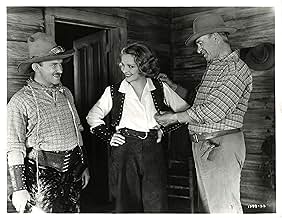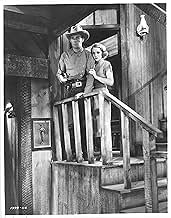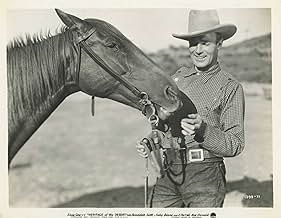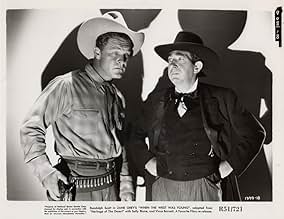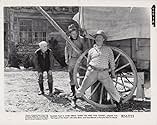Aggiungi una trama nella tua linguaNabb controls the pass and lets all the ranchers through except Holderness and his stolen cattle. When Nabb refuses to sell, Holderness works an his son Snap who has run up gambling debts. T... Leggi tuttoNabb controls the pass and lets all the ranchers through except Holderness and his stolen cattle. When Nabb refuses to sell, Holderness works an his son Snap who has run up gambling debts. There is more trouble when Snap becomes jealous of Judy's attraction to the surveyor Jack. ... Leggi tuttoNabb controls the pass and lets all the ranchers through except Holderness and his stolen cattle. When Nabb refuses to sell, Holderness works an his son Snap who has run up gambling debts. There is more trouble when Snap becomes jealous of Judy's attraction to the surveyor Jack. When Holderness has Snap killed, everyone heads to town for the showdown.
- Regia
- Sceneggiatura
- Star
- Lefty - Henchman
- (as Guinn Williams)
- Windy
- (as Vincent Barnett)
- Naab Man
- (non citato nei titoli originali)
- Bob Burns
- (non citato nei titoli originali)
- Ed Slade - Henchman
- (non citato nei titoli originali)
- Barfly
- (non citato nei titoli originali)
- Girl at Roulette Table
- (non citato nei titoli originali)
- Naab Man
- (non citato nei titoli originali)
- Cowhand
- (non citato nei titoli originali)
- Henchman
- (non citato nei titoli originali)
- Red - Henchman
- (non citato nei titoli originali)
- Naab Man
- (non citato nei titoli originali)
- Fred
- (non citato nei titoli originali)
Recensioni in evidenza
This is noted director Henry Hathaway breakout picture and he offers up some nice panoramas and carefully composed shots, which serve to give this movie its poetic or even dreamlike atmosphere. But, for the realist, the jumping from Joshua Tree-studded desert to oak woodlands to pine-studded ridge tops and back again in the confines of a local story is a bit hard to accept, unless one accepts being in a dream.
The story is involving, as one might expect, being that it is sourced from Zane Grey. It struck me that the delivery of the dialog was powerfully effective and engaging, so much so that it was disappointing to see the program come to a close. Why the story unfolded so satisfyingly was in large measure owing to the faces delivering it, which are diverse and fascinating, and to the voicing, which although admittedly delivered a little stiffly at times, is strong and consistently appropriate for each character.
The men in this story exist in a harsh and dangerous world, but this is contrasted with softness with the appearances of the very feminine Sally Blane. Sally's very non-1890 look is just one more example of the film's dreamlike demeanor. She of course photographs beautifully, including in the warm glow of a campfire's light. Deeper into the film Sally walks along a windswept rocky ridge studded with pine trees looking for Randolph in the softest of summer dresses, fluffing her hair as she anticipates seeing him. Obviously this scene couldn't be from real life! The soft-focus scene where the two "bed down" in the moonlight in close proximity to one another after having had a romantic day together, he in a bed of pine needles on the ground and she perched above him on a platform in a pine tree, is perhaps one of the most romantic of moments in cinematic history.
The film has plenty of great dialog. One fun passage occurs out of doors in a tree grotto when the villain Judd Holderness (actor Daniel Landau) tells one of the men under his thumb, in his ominously-toned voice, "I staked you to plenty, savvy? Maybe your old man would like to know what happened to his horse money!" The character Snap Naab replies nervously, "You wouldn't do a thing like that, would you?" Holderness kicks at the ground like a horse and replies sternly, "I do things like that every ten minutes." This is really great stuff, as they say!
For 1932, "Heritage of the Desert" is a slice above a standard B-western in budget and appointment, and even has some appreciated music, including a beautiful medley as backdrop in the bar scenes as well as non-intrusive scoring in well-up moments when romance or tension develop. In summary, "Heritage of the Desert" has a fine story; a strong romance story line; the requisite horse, gun play, and fistfight action; considered cinematography; and riveting dialog delivery. It is an excellent hour's worth of lush and dreamy western movie entertainment.
This was Scott's first official western, but Blane got more attention because she played opposite legendary Tom Mix in three of his action films during the late 1920s. And if she could ride a horse and keep up with Mix, she was a natural for the part. Here, Scott plays an earnest land surveyor who is hired by ranch owner J. Farrell MacDonald to protect his property, which may be snatched by an unscrupulous land baron --who just happens to be wooing Sally! She catches the attention of Randy, or vice versa, and you know what comes next.
Action and some good fistfights are guaranteed, but its the romance angle that gets equal time, and rightly so. Behind the scenes, Randolph Scott and Sally Blane were a Hollywood item, on the front pages of fan mags of the era, making the cover of TRUE ROMANCE in 1933, which is now a collector's item.
Director Henry Hathaway, who made his debut with this film, cleverly let the cameras roll on their romantic scenes together... and they seemed to be havin' fun. HERITAGE OF THE DESERT was also notable for its on location photography, which for a lower budget film, was a smart move. With the success of this western, Paramount immediately produced Zane Grey's WILD HORSE MESA, which may have attracted even more of attention because of Sally Blane's PRE-CODE low cut dress on several posters and studio publicity shots. They are still in circulation! Whether this had anything to do with their on screen/off screen relationship, who knows, but audiences loved it.
More over, in a juicy bit of gossip... Sally was later criticized (by conservative organizations) of dressing too casually on film. These crazy, young Hollywood kids! "Be young, be foolish, but be happy."
Thank you, Randy and Sally, for blazing the trail. Always on dvd, collectors box released via Alpha Video 2006.
Heritage Of The Desert one of the many Zane Grey novels that Paramount was filming during these years casts Randolph Scott as an eastern surveyor hired by J. Farrell MacDonald to get an accurate read on his boundary. That's something that neighboring rancher David Landau doesn't like probably because the result he knows would go against him.
Landau's our villain of the piece and is cut from the Snidely Whiplash mold which becomes abundantly clear when toward the end of the film he decides that he ought to marry Sally Blane who has no interest in him believe me. In fact that's the second part of the trouble Randy's walked into.
Blane is the daughter of MacDonald's late partner and she has a piece of the MacDonald spread outright. It's been assumed that she'd be marrying Gordon Westcott who is MacDonald's son. But Westcott's a weak sort who Landau has taken much advantage of. And until Scott arrives on the scene looking at what else was around, Blane probably thought she was getting a bargain.
So mix the elements of love and land feud and the answer is all's fair in love and range war.
It's very apparent that even cast as a somewhat green easterner Randolph Scott would have a good future in westerns. Blane's resemblance to her more well known sister Loretta Young is unmistakable and Landau is his usual villain, mean and tough and he does work through the more old fashioned aspects of his stock villain character.
And for double historical interest, Heritage Of The Desert is the first feature film directed by Henry Hathaway who was contracted to Paramount for many years starting with this film.
I'm sure the Saturday matinée crowd delighted in this one.
Lo sapevi?
- QuizThe 20 Zane Grey stories sold by Paramount to Favorite Films for theatrical re-release, and then to Unity Television Corp. for television broadcast, are as follows: The Light of Western Stars (1930) (aka "Winning the West"), L'ultima carovana (1931) (aka "Blazing Arrows"), Heritage of the Desert (1932) (aka "When the West Was Young"), The Mysterious Rider (1933) (aka "The Fighting Phantom"), The Thundering Herd (1933) (aka "Buffalo Stampede"), Man of the Forest (1933) (aka "Challenge of the Frontier"), To the Last Man (1933) (aka "Law of Vengeance"), Il canto del West (1934) (aka "Caravans West"), Rocky Mountain Mystery (1935) (aka "The Fighting Westerner"), Drift Fence (1936) (aka "Texas Desperadoes"), Desert Gold (1936) (aka "Desert Storm"), The Arizona Raiders (1936) (aka "Bad Men of Arizona"), Arizona Mahoney (1936) (aka "Arizona Thunderbolt"), Forlorn River (1937) (aka "River of Destiny"), Thunder Trail (1937) (aka "Thunder Pass"), Il sentiero della vendetta (1937) (aka "Hell Town"), The Mysterious Rider (1938) (aka "Mark of the Avenger"), Heritage of the Desert (1939) (aka "Heritage of the Plains"), Knights of the Range (1940) (aka "Bad Men of Nevada"), The Light of Western Stars (1940) (aka "Border Renegade").
- BlooperThe story takes place in 1890, but Sally Blane's hairstyles, make-up and demeanor are strictly 1932, likewise the girls in the saloon.
- Citazioni
Dance Hall Girl: Hello, Stranger
Jack Hare: How did you know I was a stranger?
Dance Hall Girl: Because I don't know you. Anybody I don't know is a stranger.
- ConnessioniFeatured in Golden Saddles, Silver Spurs (2000)
I più visti
Dettagli
- Tempo di esecuzione1 ora
- Colore
- Proporzioni
- 1.37 : 1
Contribuisci a questa pagina


